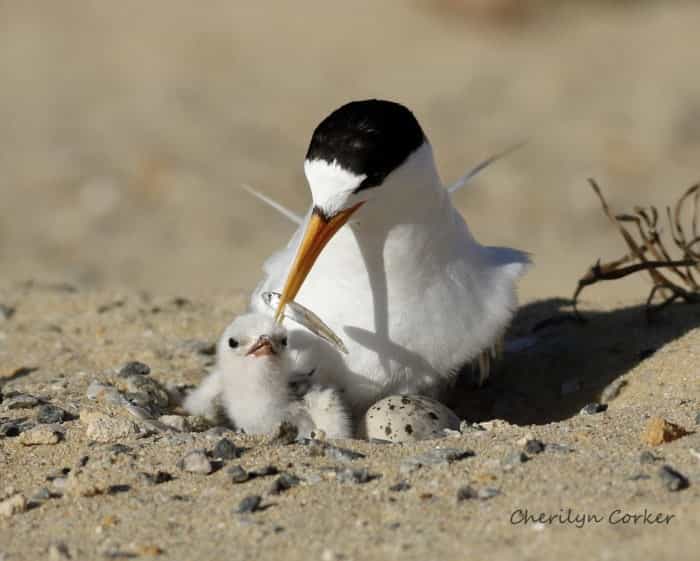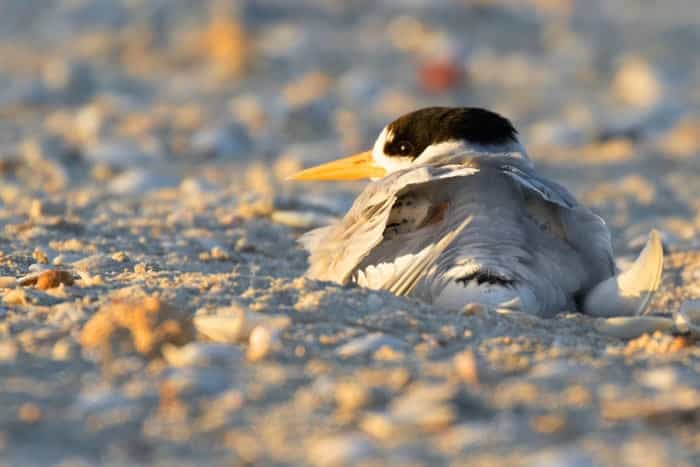A single cat wiped out an entire colony of fairy terns

SCIENTISTS SAY that cats kill more than one million birds in Australia every day. But what’s not so clear in that statement is the damage a single cat can wreak on an entire population of birds.
There have been historic stories of cats causing the extinction of bird species on remote islands, like the Stephens Island wren of Stephens Island in the Cook Strait.
As the story goes, the wren was supposedly wiped out by ‘Tibbles the cat’, the lighthouse keeper’s companion.
Marine ecologist Claire Greenwell, who mostly studies small marine birds, was recently witness to a similar event in Australia.
In 2018, Claire was studying a nesting population of fairy terns who had chosen Mandurah in south-western Australia as their breeding site, something the townspeople were proud of.
“Mandurah had a long history of nesting fairy terns,” says Claire.
Initially the locals doubted whether the new sanctuary at the mouth of the Peel-Harvey Estuary would be utilised by the birds after it was established in 2017.
“But when the birds arrived everyone was delighted,” Claire says. “We had people coming down to learn of the latest developments and having a look through spotting scopes to get a closer glimpse of the birds.
“There was amazing stewardship within the community. They became ‘our birds’.”
At the peak of the breeding season in November, Claire observed 111 nests, which consisted of one to three eggs per nest.
What had begun as a great success story, however, turned into a nightmare by mid-November, when the chicks began to hatch.

A fairy tern feeding its chick. (Image credit: Cherilyn Corker)
“I was at the colony site from sunrise to sunset for a number of days,” says Claire.
“I was attuned to what was going on, documenting which nests had hatched and where there were new chicks.”
Claire eventually began wondering why seemingly healthy chicks were turning up dead in the morning.
“I had a feeling that something could be happening at night that was causing adults to leave the nest and perhaps the chicks were getting cold.
“As it was an active nesting colony and to limit to disturbance to the nesting birds, we didn’t get close enough to see what was really at play. Initially, we assumed it could be something natural.”
However, it wasn’t long before Claire and other volunteers found cat tracks in and around the colony and bodies of adult fairy terns decapitated with their chests opened.
“That’s when it became real,” Claire says.
Wildlife cameras set up around the nesting colony detected a grey cat, which was trapped immediately and returned to its owner, who lived in an apartment block across the road. This cat is thought to have had a limited impact on the colony.
At that point, a letter was sent out to residents requesting that cats be kept indoors until the end of the fairy tern breeding season. But the trouble didn’t stop there.
“The neighbours in the apartments across the road began reporting a white cat in the sanctuary and on a number of occasions they chased the cat away.
“One of the neighbours became so invested in the colony she barely slept. She would wake up just to watch over the colony from her balcony.”
The white cat was observed near the sanctuary on six different nights between 26 November and 12 December, when it was eventually trapped and euthanised. The cat was found to be desexed, but was not microchipped or collared.
“It was stressful,” Claire recalls. The result was the death of six adults, some 40 chicks and the complete failure of 111 nests – the entire colony.
“We had the hope that we’d get some birds through to fledgling, but unfortunately by the time they captured the cat it was too late.”
By then, a nankeen kestrel had begun picking off the remaining unguarded chicks, with their parent’s biological need to protect their clutch outweighed by their need to protect themselves.
Right now, it’s difficult to determine whether the fairy terns will return next season.

A fairy tern with a chick under its wing. (Image credit: Claire Greenwell)
The biggest takeaway for Claire of this unique opportunity for scientific study was that the trap-neuter-release method doesn’t work here in Australia.
Trap-neuter-release has been proposed as a method to tackle feral and stray cat populations. According to Claire, it doesn’t address the ongoing damage to wildlife caused by those cats after they’re released.
Ecologist John Woinarski, who recently co-authored the book Cats in Australia: Companion and Killer, says that the incident recorded by Claire is emblematic of what occurs across Australia, and shouldn’t be treated as a singular or unusual case.
John also reflected on the harm the incident has done to the community. “As urban dwellers it’s wonderful that you can have such biodiversity spectacles like the fairy tern colonies of Mandurah.
“There is biodiversity in urban areas and we need to protect that and be receptive to the value it brings to our lives.”
The Western Australian Government has just concluded a review into dog and cat ownership, which considered measures such as a ‘cat curfew’. The results will be released in the near future.
Having published her findings in Animals, Claire is advocating for responsible cat ownership.
“Cats are wonderful pets, but owning a cat comes with responsibility. Providing your pet with a safe, secure environment that protects them from harm and reduces their impacts on wildlife is important.
“Cats can adapt to an indoor lifestyle and there are plenty of DIY cat enclosure options for people wanting outdoor time for their cat. If you own a dog, you don’t let it roam the streets, it should be no different for a cat.”
For more advice on responsible pet ownership visit the Australian Government’s Environment and Energy Department website.
You can ready Claire’s paper in full here.
Receive great savings and a gift when you subscribe to our magazine




